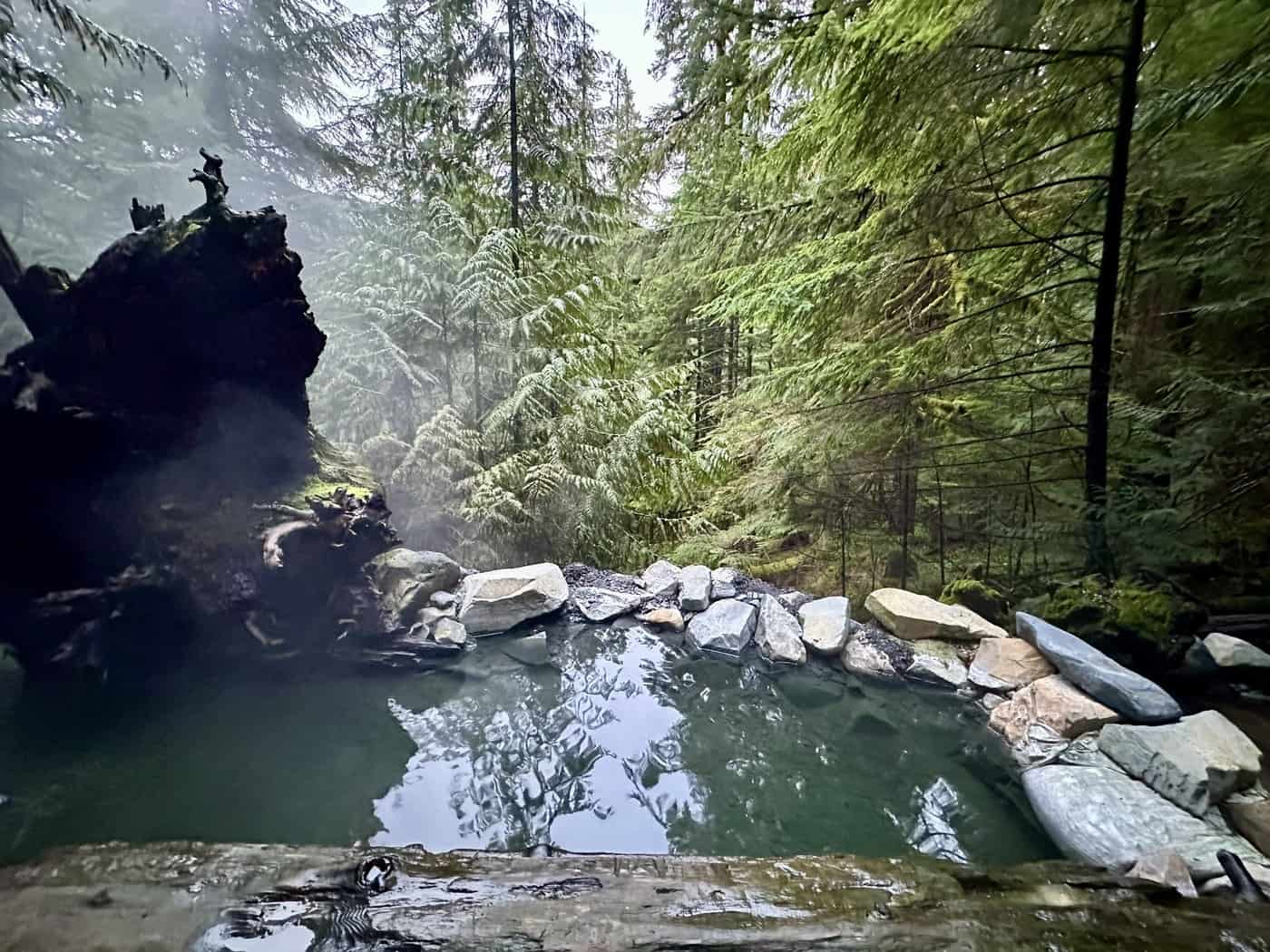The first time I slipped into the mineral-rich waters of Sol Duc Hot Springs, surrounded by towering old-growth cedars and the sound of rushing water, I understood why Indigenous peoples have considered these places sacred for thousands of years. There’s something transformative about letting thermal waters ease away the day’s tensions while moss-draped branches create a natural cathedral above you.
Washington State offers some of the most spectacular natural hot springs in the Pacific Northwest, each with its own character and setting. From developed resort hot springs to wild backcountry thermal pools, these Washington State hot springs provide the perfect opportunity to slow down, connect with nature, and experience the healing power that’s drawn people to these geothermal waters for generations.
Read Also: Hot Springs near Seattle and Scenic Drives in WA
Olympic Hot Springs: A Wilderness Sanctuary
Hidden deep within Olympic National Park, Olympic Hot Springs requires commitment and that’s precisely what makes it magical. The moderate 2.5-mile hike along the old Elwha River road leads to a series of natural pools tucked into the forest.
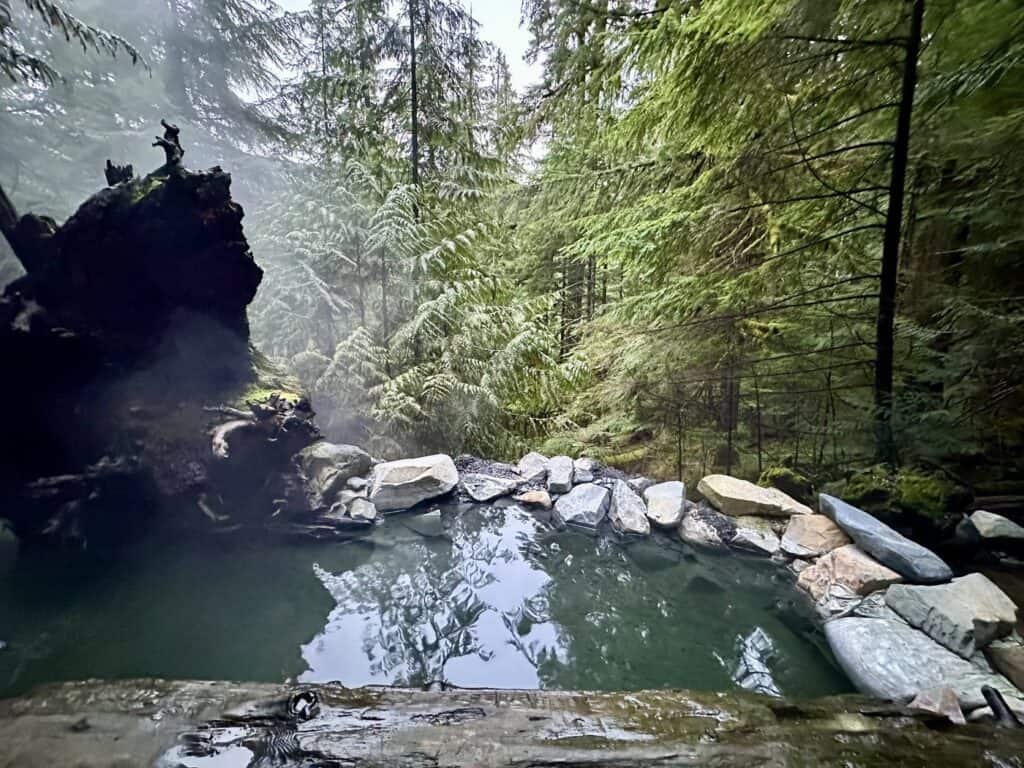
The Experience: Multiple pools of varying temperatures (ranging from 99°F to 105°F) cascade down natural terraces. The clothing-optional tradition here creates an atmosphere of complete relaxation and body acceptance. Early morning visits often mean having the springs entirely to yourself, with only the sound of nearby Boulder Creek for company.
Getting There: From Port Angeles, take Highway 101 west to the Elwha River Road. Park at the gate and hike 2.5 miles on the old road. The springs are well-marked but require a short scramble down to the pools.
Best Time to Visit: Late spring through early fall for easiest access. Winter visits are possible but require more preparation for potentially icy conditions.
Essential Tips:
- Bring a headlamp for early morning or evening soaks
- Pack out everything you pack in because this is pristine wilderness
- The hike takes about 45 minutes each way at a comfortable pace
- No facilities available so plan accordingly
Where to Stay Near Olympic Hot Springs
Sol Duc Hot Springs Resort – The most convenient base, with developed hot springs pools and comfortable cabins. Open seasonally from late March through October.
Lake Crescent Lodge – Historic lakefront lodge offering a more upscale experience, about 45 minutes from the trailhead.
Port Angeles Inn – Budget-friendly option in town with easy access to the park.
Nearby Dining & Attractions
Dining:
- Kokopelli Grill (Port Angeles) – Local favorite for creative Pacific Northwest cuisine
- Next Door Gastropub (Port Angeles) – Craft cocktails and elevated pub fare
Breweries:
- Port Angeles Brewing Company – Local brewery with rotating taps
- Barhop Brewing – Small batch brewery with a cozy atmosphere
Don’t Miss: Hurricane Ridge for panoramic mountain views, or the nearby Elwha River restoration project, which is one of the largest dam removal projects in U.S. history.
Sol Duc Hot Springs: Comfort with Character
Sol Duc represents the perfect middle ground between wilderness and comfort. The resort’s three developed pools sit within walking distance of cozy cabins, making it ideal for those who want the hot springs experience without sacrificing amenities.
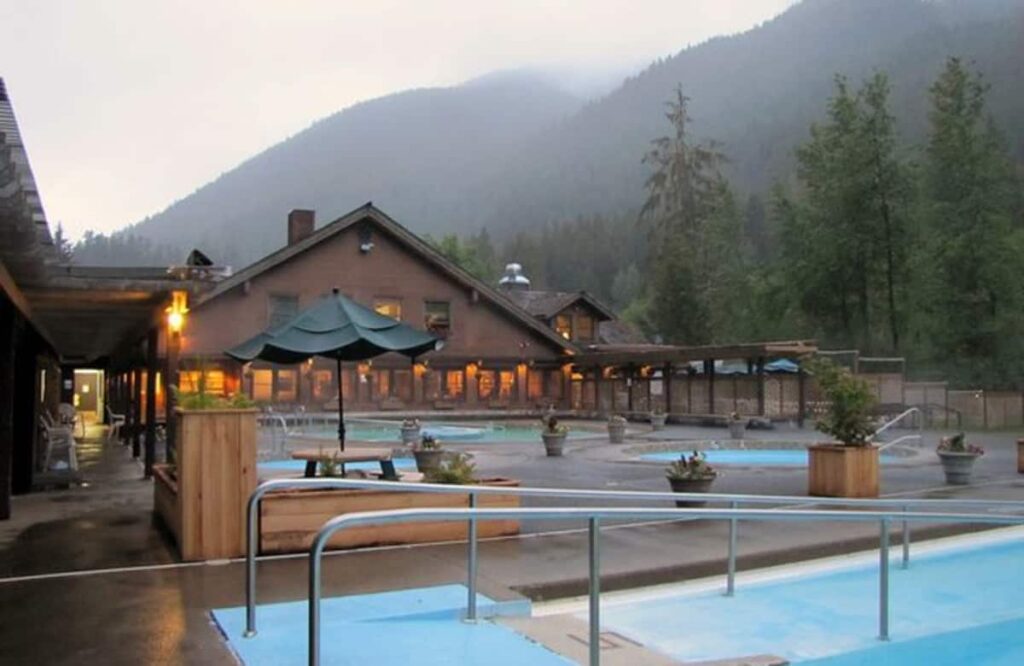
The Experience: Three soaking pools maintained at different temperatures (99°F, 101°F, and 104°F) plus a freshwater swimming pool. The setting feels almost Japanese in its serene integration with the surrounding old-growth forest. Unlike many commercial hot springs, Sol Duc maintains a peaceful, unhurried atmosphere.
Getting There: From Highway 101, turn south on Sol Duc River Road and follow it 12 miles to the resort. The road is well-maintained and suitable for all vehicles.
Best Time to Visit: The resort operates seasonally from late March through October. Early season (April-May) offers fewer crowds and spectacular wildflower blooms along the trails.
Unique Features:
- Three naturally heated mineral pools
- Massage services available on-site
- Extensive trail system including routes to Sol Duc Falls
- Restaurant and gift shop
Where to Stay
Sol Duc Hot Springs Resort – Stay right at the springs in cozy cabins or RV sites. Book well in advance, especially for summer weekends.
Log Cabin Resort – Lakefront cabins on Lake Crescent, about 30 minutes away.
Nearby Experiences
The Sol Duc area offers some of the most accessible old-growth hiking in the Olympics. The 1.6-mile Sol Duc Falls trail is nearly level and rewards you with a dramatic 48-foot waterfall. For a longer adventure, the Sol Duc River Trail continues deep into the park’s backcountry.
Kennedy Hot Springs: A Backpacker’s Reward
For those seeking a true wilderness hot springs experience, Kennedy Hot Springs in the Glacier Peak Wilderness area delivers solitude and stunning alpine scenery in exchange for a challenging 5.2-mile hike. There used to be 3 pools but a flood in 2013 wiped them out.
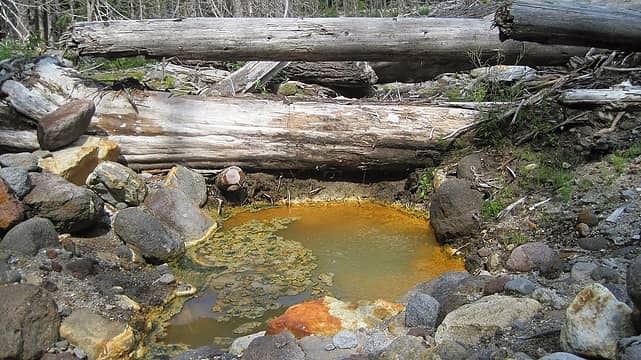
The Experience: 1 rustic soaking pool fed by 104°F natural springs, situated at 3,300 feet elevation with views of Glacier Peak. The sense of accomplishment from reaching these remote pools makes the soak even more satisfying.
Getting There: From Darrington, take Forest Road 20 (Mountain Loop Highway) to the Kennedy Ridge trailhead. The trail follows an old mining road before climbing through forest to the springs.
Best Time to Visit: July through September when the trail is typically snow-free. Early fall offers the bonus of golden larch colors.
Essential Preparation:
- This is a backcountry experience so bring all necessary camping and safety gear
- Wilderness permit required for overnight stays
- Trail can be challenging with river crossings and elevation gain
- Leave No Trace principles essential
Base Camp Options
Darrington Camping: Several Forest Service campgrounds along the Mountain Loop Highway provide convenient staging areas.
Mountain Loop Highway Attractions
The scenic Mountain Loop Highway offers numerous stops including the Big Four Ice Caves (seasonal) and multiple waterfalls. The historic mining town of Monte Cristo makes for an interesting day hike from the Barlow Pass trailhead.
Scenic Hot Springs: Accessible Relaxation
Located along the scenic Cascade Loop, Scenic Hot Springs provides a more accessible mountain soaking experience with impressive views of the North Cascades.

The Experience: Several natural rock pools perched on a hillside overlooking the Wenatchee River valley. The 1.2-mile trail is moderately steep but manageable for most fitness levels. Temperatures range from 108°F to 115°F in the various pools.
Getting There: From Highway 2 east of Leavenworth, turn north on Coles Corner Road and follow signs to the trailhead. High-clearance vehicles recommended for the final stretch.
Best Time to Visit: Year-round access, though winter requires extra caution on potentially icy trails. Spring offers snowmelt waterfalls, while fall brings beautiful larch colors.
What Makes It Special:
- Spectacular valley and mountain views
- Multiple pools to choose from
- Relatively easy access compared to other wilderness springs
- Clothing optional by tradition
Where to Stay Near Scenic Hot Springs
Sleeping Lady Mountain Resort (Leavenworth) – Boutique resort emphasizing wellness and connection with nature.
Hotel Pension Anna (Leavenworth) – Austrian-style inn in the heart of the Bavarian village.
Icicle Village Resort (Leavenworth) – Family-friendly resort with multiple accommodation types.
Leavenworth Area Attractions
Dining & Drinking:
- Watershed Cafe – Farm-to-table dining with local ingredients
- Icicle Brewing Company – Local brewery with German-inspired beers
- Visconti’s Italian Restaurant – Long-established Italian favorite
Activities:
- Year-round outdoor recreation from river rafting to cross-country skiing
- Seasonal festivals including Oktoberfest and Christmas Lighting
- Numerous hiking trails in the Alpine Lakes Wilderness
Carson Hot Springs: Historic Healing Waters
Dating back to 1897, Carson Hot Springs Golf Resort represents Washington’s longest continuously operating hot springs resort. The mineral-rich waters have drawn visitors seeking therapeutic benefits for over a century.
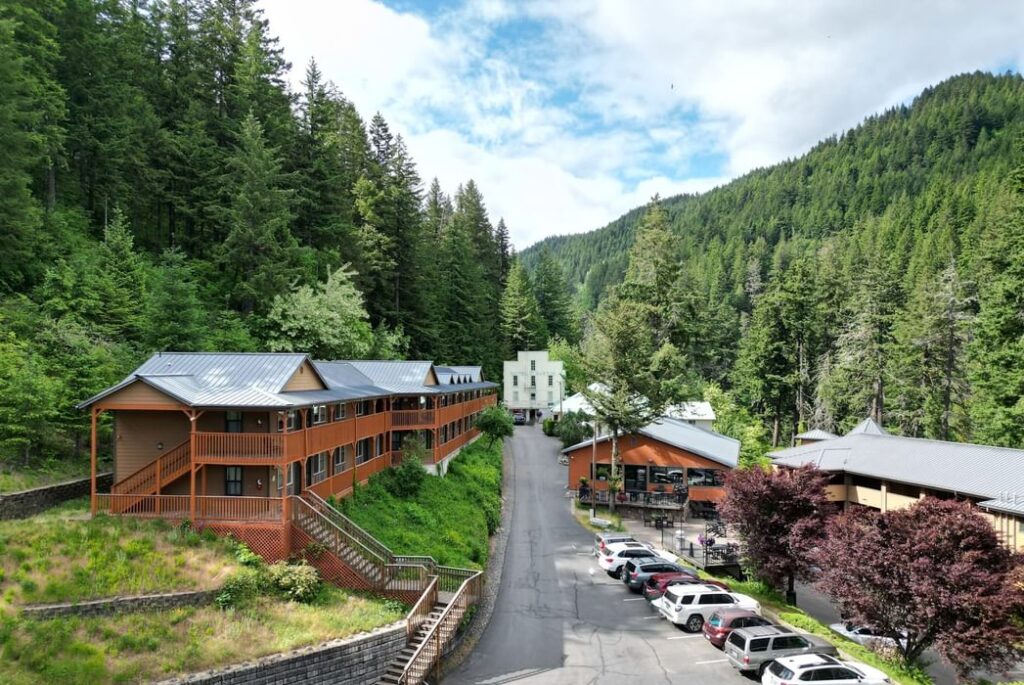
The Experience: The historic bathhouse maintains old-world charm with individual soaking tubs and traditional treatments. The 126°F spring water is naturally rich in minerals including lithium, known for its calming properties.
Getting There: Located in the Columbia River Gorge, about 50 miles east of Portland, Oregon, and easily accessible via Highway 14.
Year-Round Operation: Unlike many Washington hot springs, Carson operates throughout the year, making it perfect for winter soaking sessions.
Unique Offerings:
- Historic bathhouse with individual tubs
- Golf course on-site
- Traditional hot springs treatments and massages
- Restaurant and lodging available
Accommodations
Carson Hot Springs Golf Resort – Stay right at the springs in the historic hotel or modern cabins.
Columbia River Gorge Attractions
Columbia River Gorge National Scenic Area – Numerous waterfalls including nearby Bonneville Dam and fish ladder.
Dining:
- Walking Man Brewing (Stevenson) – Craft brewery with Columbia River views
- Big River Grill (Stevenson) – Casual dining with local Columbia River cuisine
Baker Hot Springs: Remote Wilderness Soaking
Hidden in the Mount Baker-Snoqualmie National Forest, Baker Hot Springs requires a moderate 2-mile hike but rewards visitors with one of the most pristine settings in the state.
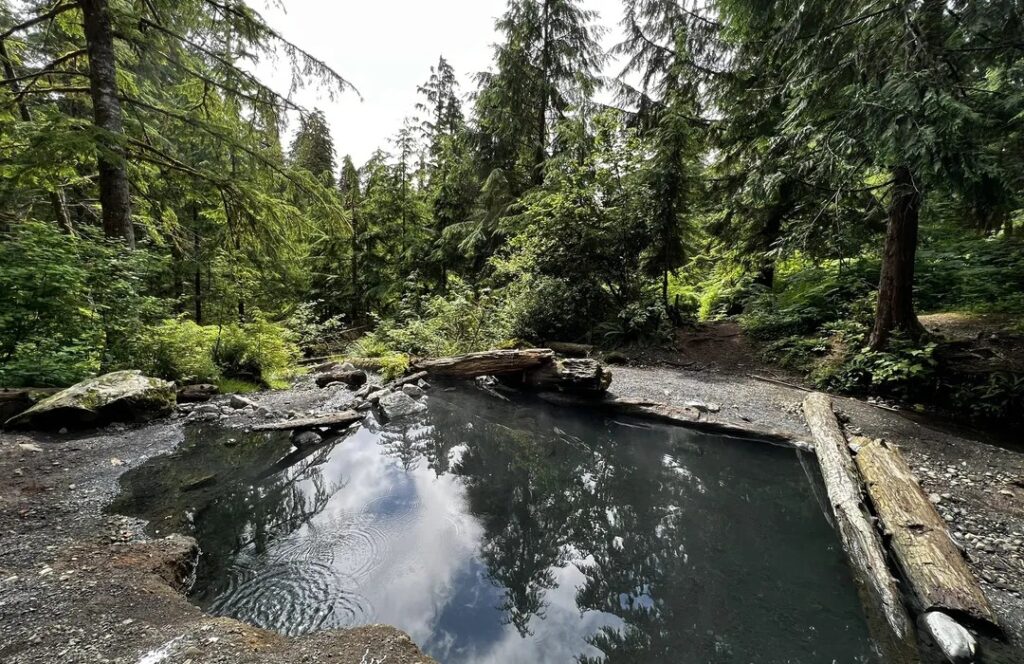
The Experience: Two natural rock pools maintained by volunteers, nestled alongside Baker River with views toward Mount Baker on clear days. The 99°F to 104°F waters provide perfect soaking temperatures year-round.
Getting There: From Concrete, take Baker Lake Road north, then turn east on Forest Road 1144. The trail begins at the end of the drivable road. High-clearance vehicle recommended.
Best Time to Visit: Accessible year-round, though winter access requires more preparation. Summer offers the warmest weather for the hike, while fall provides excellent mushroom foraging opportunities along the trail.
Trail Tips:
- Well-maintained trail suitable for intermediate hikers
- Stream crossings may require caution during high water
- Popular with locals, so weekday visits offer more solitude
- Pack out all trash to preserve this pristine location
North Cascades Base Camps
North Cascades Lodge at Stehekin – Remote lodge accessible only by boat, plane, or foot, offering true wilderness immersion.
Concrete Area Camping: Several Forest Service campgrounds provide convenient staging areas for Baker Hot Springs visits.
Regional Attractions
The North Cascades offer some of America’s most dramatic mountain scenery. Consider combining your hot springs visit with a drive through North Cascades National Park on Highway 20 (open seasonally), or exploring the Skagit River Bald Eagle Natural Area during winter months.
Hot Springs Etiquette and Safety
Understanding proper hot springs etiquette ensures these special places remain welcoming for all visitors:
Temperature Wisdom: Hot springs temperatures can vary significantly and change with seasons and water levels. Test pools gradually and listen to your body. Most comfortable soaking occurs between 98°F and 104°F.
Respect the Environment: Practice Leave No Trace principles strictly. Pack out all trash, use biodegradable soap (if any), and avoid disturbing the natural setting.
Social Considerations: Many Washington hot springs have clothing-optional traditions. Respect others’ choices and comfort levels. If you’re unsure, observe others or ask politely.
Health and Safety:
- Stay hydrated, especially during longer soaks
- Limit initial sessions to 15-20 minutes
- Avoid hot springs if you have certain health conditions or are pregnant
- Never soak alone in remote locations
Planning Your Hot Springs Journey
Packing Essentials:
- Quick-dry towel and flip-flops
- Water bottle and snacks
- First aid kit for backcountry springs
- Headlamp for evening soaks
- Appropriate layers for changing weather
Seasonal Considerations: Washington’s hot springs offer different experiences throughout the year. Summer provides easiest access but larger crowds. Fall offers beautiful colors and fewer people. Winter soaking creates magical contrasts between hot water and cold air, while spring brings wildflowers and rushing streams.
Leave No Trace: These natural treasures exist because generations of visitors have treated them with respect. Continue this tradition by leaving only footprints and taking only photographs.
The Deeper Soak: Why Hot Springs Matter
Beyond the obvious relaxation benefits, Washington State hot springs connect us to something elemental. Indigenous peoples of the Pacific Northwest have long recognized these natural thermal springs as sacred locations where the earth’s energy surfaces to heal both body and spirit.
In our hurried world, these Washington hot springs offer rare opportunities to be fully present. There’s no scrolling, no multitasking, just the simple act of letting warm mineral water and natural beauty work their ancient magic. Whether you choose the easy accessibility of Sol Duc Hot Springs or the wilderness challenge of Kennedy Hot Springs, you’re participating in a timeless ritual of renewal at some of the best hot springs Washington State has to offer.
Each spring has taught me something different about slowing down and paying attention. The lesson isn’t just in the destination—it’s in taking time to notice the moss-covered rocks, the way light filters through old-growth canopy, the surprising conversations that emerge when people put aside their usual defenses and simply soak together.
These waters have been here long before us and will remain long after. We’re temporary visitors to places that measure time in geological epochs rather than Instagram posts. That perspective shift alone might be the most therapeutic element of any hot springs experience.
Have you discovered Washington State hot springs experiences that changed how you think about slowing down? We’d love to hear about your favorite natural hot springs and the moments that made them memorable.
Content creator and writer for multiple websites including All About Glamping, Fit Living Lifestyle, and Live Dream Discover. A full-time traveler who has spoken at various travel conferences around the world.

